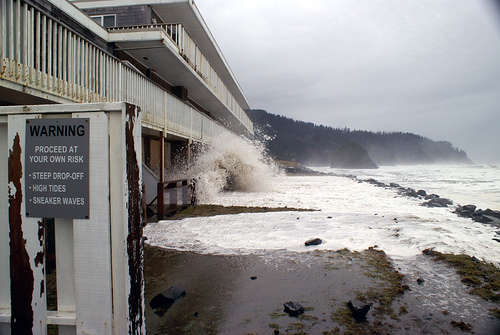Climate change in the Northwest: Monster waves edition
No. How about monster waves, like this one from Oregon State University's Flickr stream:

Note the high point of the wave coming up about even with the top floor of that condo building.
Recently, Oregon State University released an analysis of wave data from deep-water buoys floating in the waters off the Pacific Coast of Washington and Oregon. Specifically, they wanted to know whether the buoy data supported previously accepted estimates of maximum wave heights. In a word, no:
The new assessment concludes that the highest waves may be as much as 46 feet, up from estimates of only 33 feet that were made as recently as 1996, and a 40 percent increase. December and January are the months such waves are most likely to occur, although summer waves are also significantly higher.To be clear, these are storm-driven waves. Waves that originate from the action of wind upon the ocean's surface. These are not tsunami waves, which are a whole other phenomenon. And this study is only concerned with the outer coast. Waves within the Puget Sound are driven almost entirely by local wind phenomena within the Sound.
The study also reports that the height of a "100-year event" wave could exceed 55 feet. Surf's up!
But 100-year events, which are common in the insurance industry as a measure of the worst thing you'd expect to happen every century or so, are kind of hard to wrap your head around. Between wind storms, heavy rains, and the occasional blizzard we in the Puget Sound are much more familiar with what to expect on a scale of about 5 years (about as often as those kinds of events happen). I asked OSU geoscientist Peter Rugerrio what the 5-year expected wave height would be:
A value of about 45 feet would approximate the 5-year event for the outer coast. [...] There is a lot of variability, but with the same assumptions used [in the study] a 45 foot 5-year event would be reasonable.Note, even that is considerably higher than the previous 33 foot estimate. Why should we care? From the OSU news release:
Increasing wave heights [...] have had double or triple the impact in terms of erosion, flooding and damage as sea level rise over the last few decades.In other words, bigger waves mean a double-whammy of damage along with that from now-inevitable sea level rise. When high offshore waves reach land, they dissipate incredible quantities of energy as they break. Of particular concern is "swash," the water that a breaking wave forces onto dry land. Like this:

That image, also courtesy of OSU, is from a storm in 2008. Imagine if that swash had one of those 45- or 55-foot offshore waves backing it up.
These large waves are primarily driven by weather patterns, such as El Nino events, which are expected to ramp up as the Earth's climate warms. We'll get El Nino events more often and more severely than before, which means more waves, more coastal erosion, more damage to sensitive coastal ecosystems, and more damage to human property as well.
The point of all this is not to be a doomsayer or get everybody down. We just need to recognize that climate change is real. It is now. And it is here.
Forewarned is forearmed.


Comments:
Post a Comment
By posting a comment, you agree to be bound by the Northwest Progressive Institute's Comments Policy, which may be updated at our discretion.